The photographic process is a grand illusion from top to bottom. Think about it. Everything about the process is visual trickery. Photography provides a reasonable facsimile of real-life perception, and luckily, your brain’s visual cortex is very forgiving and willing to play along with this ruse.
Here’s what I mean.

Your brain is pretty smart; way smarter, adaptable and intelligent than we sometimes give it credit for. Human perception takes place on a completely different level than photography (or even videography). But photographic science and advanced camera functions do hold certain advantages over nature’s system. Here’s a look at a comparison of the two systems.
Motion / Still Life
Your camera is able to capture slices of time and literally freeze motion in its tracks. Camera shutter speeds slice and dice life into instances of time lasting just thousandths of a second each. Only when we fail to set the shutter speed and (ISO) sensitivity properly are objects in motion recorded as a blur.

Your eyes, on the other hand, have rarely seen anything absolutely still, unless it is a rock formation or building. Even then, our view is constantly changing simply because our body moves continually.
While your eyes capture thousands of frames each second, they process the images quite differently than your camera. They stream high-speed snapshots to your brain’s visual cortex – two at a time (right and left views) providing dimension and shape. And they do this all day, every day. No batteries or memory cards are required.
Your eyes shift and refresh their view thousands of times every second to paint complete three-dimensional moving scenes in your mind. This is perpetual “streaming” at the speed of light.
Video
The illusion of moving pictures (or movies) comes close to replicating what human eyes perceive as motion. The action portrayed in motion pictures is accomplished when single-frame images are flashed onto a screen sequentially at the same speed that they were recorded. The process works effectively to simulate what the human eye processes at much higher rates.
The major difference is the processing speed. Specific video codecs (computer word for the compression and decompression process) involve industry-standard capture/playback speeds (frames-per-second) designed to match the processing power of various playback systems. Videos are recorded and played back at speeds up to 60/fps to trick the eye into perceiving motion instead of seeing individual frames flickering by.
Autofocus and Blurred Backgrounds
The camera focuses on a single plane or depth of field and blurs the rest of the picture. You have the option to automatically focus on all subjects in the scene or select specific pinpoint areas.
If you set the camera to autofocus, you must remember that the camera always seeks and focuses on the objects with the highest contrast ratio in the scene. To control this you may select between face detection, autofocus tracking, multiple focus points (zone focus) or overall scene settings to tell the camera your preference.
Camera focus is all about managing the blur; making the eye concentrate on a particular part of the scene.

Your eyes don’t really see blurs at all. They automatically focus on the single subject of your attention and gradually defocus and separate the view of the non-subject areas. This is quite different than camera “bokeh.” Close one eye and view a scene in the room, then switch eyes and notice how the background shifts.
The human eye displaces subjects in the background while the camera attempts to blur them. We’ve been conditioned to accept photo blurs as if they are a part of real life, even though they aren’t!
Two Versus Three-Dimensionality
Single lens cameras capture only two-dimensional images; with height and width. Items in focus are limited to a single defined “plane,” or distance from the camera. The dimension of depth is simulated by blurring objects which are not in perfect focus.
Your eyes never observe scenes in only two dimensions; they see every scene in three dimensions, through two converged horizontal viewpoints, your left, and right eyes. Your eyes adjust and shift focal length almost instantaneously. Only recently has Hollywood caught onto the 3-D trick.
Dimension, like depth, is perceived visually by slightly defocusing and horizontally shifting the two scenes behind the object in focus. This differs significantly from the camera’s method of simply blurring and softening the background. While depth can be simulated, dimension cannot be. Dimension requires a process called parallax, a word derived from the French “parallaxe” meaning “fact of seeing wrongly.”
Depth of Field
The camera uses its single lens to capture subjects from a direct frontal view. With the camera, you can also determine how much of the scene you want in focus by a managing the depth of field (DOF); blurring both the foreground and background for emphasis.
You can’t do this with your eyes. If you concentrate on an object close to you, pretty much everything behind the subject will automatically be defocussed.

Each of your two eyes sees that same subject from a slightly horizontally-offset angle, which is a very good thing! This overlapping, crisscross view allows you to see enough of the sides of each subject to sense dimension, judge distances, and safely navigate your way around obstacles. When the eye’s two views are combined, they provide a unique depth and dimension to your perception.
Try walking around when viewing the scene ONLY through your camera’s viewfinder and you’ll notice the difference.
Sphere of Focus
Camera lenses all have one thing in common. When they focus on an object a measured distance from the lens, everything else in the scene (the same distance from the lens) is also in focus. The optical nature of the spherical shape of the lens makes this happen. When you employ a wide angle lens, you can see everything in the scene in near-perfect focus.

The human eye is quite different. Our focus on a subject is actually limited to a very small radius of view, between 7-10° wide. Everything outside that window appears defocused; not blurred, but just out of sharp focus.
While our peripheral vision spans nearly 180°, only a very tight circle of view appears totally focused. The way we perceive entire scenes by our eyes is constantly shifting and sending patches of focus to the cerebral cortex, which paints a momentary scene in our mind.
Try staring at one word on this screen. You’ll notice that unless your attention shifts slightly, the words on either side of that word aren’t really “in focus.” The real magic is that both of your eyes have this agility and they both work in perfect unison, viewing the same exact spot and shifting together at precisely the same moment.
Monochrome
All digital cameras are able to record images using only the luminosity channel producing “black-and-white” images. Monochrome photographic images remove all chrominance (color) information and rely only on single color contrast (luminance) to portray the scene.
Photography’s earliest roots are in black and white photography as the development of film emulsions were able to capture only luminance (monochrome) values with the light-sensitive silver halide particles. Even color films used this same monochromatic process but added color filters to capture individual RGB light waves.

Your eyes have never experienced this phenomenon except in photographic reproduction. The eye’s rods and cones that make up the image receptors interpret every scene in full color. Red, green, and blue receptors in your eyes perform this same service for your vision.
This characteristic of photography is perhaps the most bazar example of visual forgiveness, though the eye’s rods (more receptive to the green frequency of light) are most able to perceive forms and shapes under very low lighting conditions. This is why identifying colors in low light is so difficult. Not coincidentally, the green channel of color digital photography captures the most realistic monochromatic information.
Zoom, Wide Angle, and Telephoto
You probably own either a zoom lens, a fixed-focus telephoto, or a wide-angle lens for your camera. These variable distance lenses allow you to capture scenes either closer or farther away than your eyes typically see. Your human eyes are “fixed” on a 1:1 or “real-time” vantage point.
If you want to see a subject at a different distance, you have to adjust your personal distance to the subject or view the world through magnifying lenses like binoculars.
Resolution

Here’s another area where photographic systems hold an advantage over human vision. When ultra-sharp lenses are coupled with high megapixel image sensors, the number of pixels available to publish a photo far exceeds the size and magnification capabilities of human vision. When pixels are displayed small enough to escape detection (roughly 100 per inch), image projection and reproduction sizes are nearly limitless.
Autofocus
Your camera can capture a scene in which everything is in near-perfect focus. From an object just feet away to a mountain five miles away, everything is sharp and clear. It is impossible for your eyes to view entire scenes in perfect focus, though photographic prints depend on the brain’s forgiving acceptance of this abnormal interpretation.
Y0ur eyes very rarely maintain the same focus for any period of time. Your brain stays hungry for visual information and your eyes know how to satisfy that appetite. Your eyes shift their attention rapidly to maintain their focus on moving objects.
Try staring at this page for more than 15 seconds and you’ll probably notice your eyes shifting briefly before returning to the word you were reading. Your eyes and brain have an insatiable visual appetite and a boundless curiosity.
Pixels, Dots, and Spots
![]()
And then there’s the whole pixel/halftone illusion itself. Your eyes register nature’s colors as continuous tones, colors that have no stages or gradations. A feat we graphic illusionists have never been able to reproduce. Every image we reproduce has to be broken down into minuscule particles of color so small that human vision cannot readily identify them individually (I’ve exaggerated the pixels and halftone dot sizes for those who don’t know the trick).
Something to think about
For all the similarities between the camera and the human eye, there are just as many (if not more) differences.
But in spite of those differences, we would be much the poorer without the precision of the human eye and the features of the digital camera. Appreciate both systems for what they add to your perception of life.
The post The Illusion of Photography and the Miracle of Sight appeared first on Digital Photography School.




















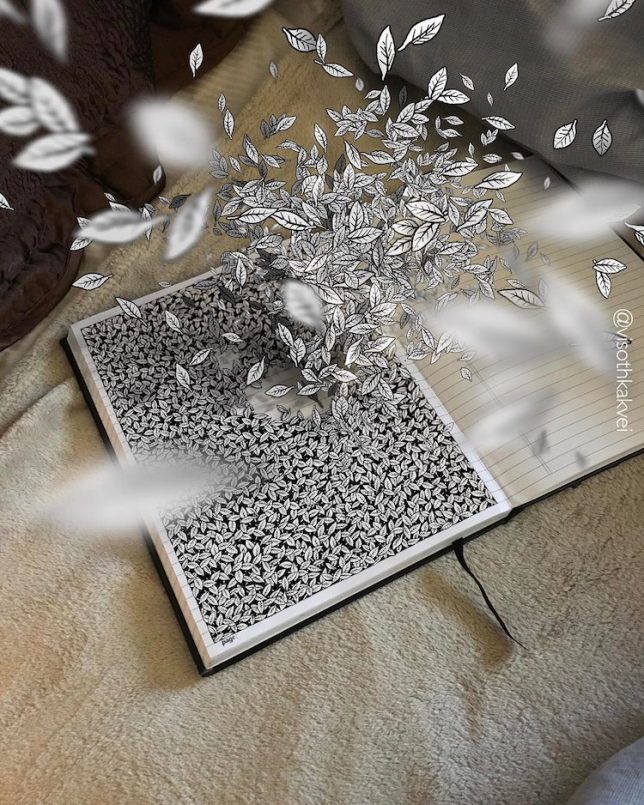








 Polar bears, orcas, lions and puppies stick their heads out of holes in the pavement so convincingly, you feel like you could actually pet them. What was once no more than a dull expanse of concrete or asphalt becomes the setting for a vivid scene that appears to jump right out of the ground when viewed from a certain angle. Originally working in chalk, Russian-born artist Nikolaj Arndt now uses a blend of pigments, water and sugar to keep his drawings from blowing away in the wind as he works.
Polar bears, orcas, lions and puppies stick their heads out of holes in the pavement so convincingly, you feel like you could actually pet them. What was once no more than a dull expanse of concrete or asphalt becomes the setting for a vivid scene that appears to jump right out of the ground when viewed from a certain angle. Originally working in chalk, Russian-born artist Nikolaj Arndt now uses a blend of pigments, water and sugar to keep his drawings from blowing away in the wind as he works.








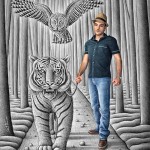














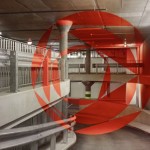
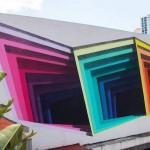
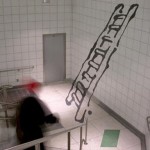













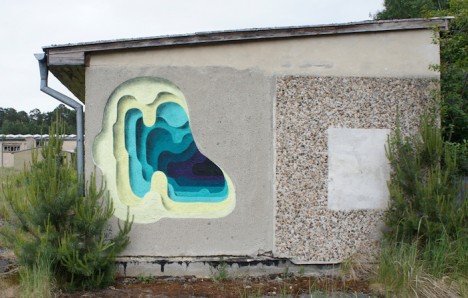








You must be logged in to post a comment.